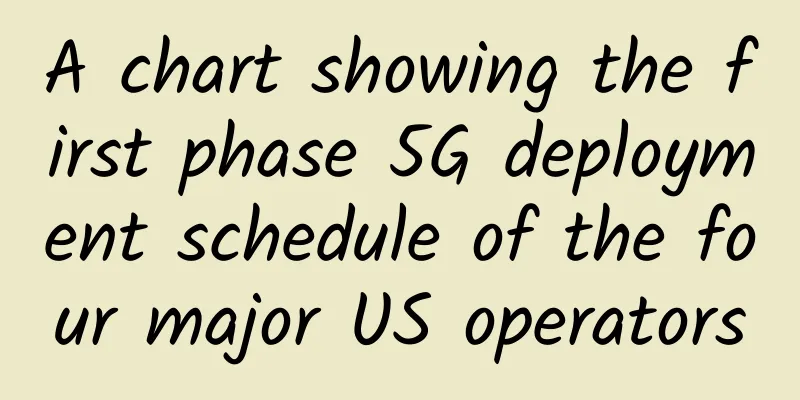A chart showing the first phase 5G deployment schedule of the four major US operators

|
5G is accelerating. 3GPP has completed the non-standalone (NSA) 5G standard in December 2017, and will complete the standalone (SA) 5G standard in June 2018. Among them, US operators have been actively conducting 5G trials and explorations since 2017. So far, the country's four major telecom operators have clear plans for the first phase of 5G deployment. 1. AT&T In 2017, AT&T launched pre-standard 5G fixed wireless trials for consumers, small businesses and education customers in Austin and Waco, Texas, Kalamazoo, Michigan and South Bend, Indiana. It also launched two AirGig trials to deliver ultra-fast, low-latency Internet over power lines, one in Georgia and one internationally. In the second half of 2018, AT&T plans to launch 5G services in Indianapolis, Atlanta, Boston, Chicago, Los Angeles, Nashville and San Francisco. In this way, AT&T hopes to become the first operator in the United States to launch 5G services. 2. Verizon Verizon has successfully completed 5G residential application trials in 11 markets in 2017, and the commercial launch will be based on user experience. In the second half of 2017, it announced a partnership with Qualcomm and Ericsson to improve network speed and capacity using synchronized multi-antenna technology. Verizon is confident in new technologies powered by millimeter wave spectrum. Recently, Verizon announced that it will launch 5G residential broadband services in 3-5 cities in the United States in 2018, initially selecting Sacramento, California as the first city to deploy 5G. The service uses wireless signals instead of copper wires or optical fibers to provide unprecedented Internet access speeds. Users will benefit from a variety of services, including broadband, mobile, IoT, 3D and virtual reality applications with sufficient bandwidth and low latency. 3. Sprint In 2017, Sprint announced that it would cooperate with SoftBank and chip maker Qualcomm to develop 5G solutions using the 2.5GHz high frequency band, and the actual deployment time was determined to be the second half of 2019. In addition, Sprint will use Ericsson's massive MIMO solution as a bridge to narrow the gap between 4G and 5G. By increasing capacity and providing high-speed data services, it can effectively support the growing needs of consumers. In addition, Sprint is working with its RAN suppliers Ericsson, Nokia and Samsung to achieve end-to-end availability of 5G NR on Sprint's 2.5GHz spectrum. Sprint's initial path to 5G marketization is to deploy 2.5 GHz Massive MIMO to achieve the goal of commercialization in 2018. 4. T-Mobile T-Mobile announced earlier that it will achieve nationwide 5G coverage in 2020. Ericsson and Intel will work with T-Mobile to deploy 5G, using 600MHz wireless frequency, to complete real-time, mobile nationwide 5G construction by 2020, with a focus on 5G hotspots. T-Mobile hopes to use low, medium and high frequency bands to complete indoor and outdoor 5G network construction. The low frequency band is 600MHz, which is twice as fast as the medium frequency band. |
<<: Evolution of network automation to network intelligence
>>: AI chip black technology inventory
Recommend
What is edge computing in IoT?
The growing number of “connected” devices is gene...
What is the difference between private and public LoRaWAN networks?
[[331465]] The low-power wide-area network (LPWAN...
5G development is timely and network construction should be moderately advanced
At present, the overall development of 5G in the ...
ReadyDedis: 50% off on all VPS, 1GB memory package starting at $2 per month, 8 data centers available
ReadyDedis is a foreign VPS business established ...
What does “IPv6” have to do with us ordinary people?
What is IPv6? Why did it attract widespread atten...
How to choose between open source self-built/hosted and commercial self-developed trace?
[[419923]] With the rise of microservice architec...
5G makes online and offline retail interesting again
5G can bring technology and innovation into the e...
An overall introduction to the 5G protocol, worth collecting!
The technical specifications related to 5G NR are...
DediPath Christmas promotion: 1Gbps unlimited traffic KVM from $15 per year, dedicated server from $39/month, multiple data centers in Los Angeles and other places
DediPath has launched a promotion for this Christ...
In the era of cloud computing, what issues should data center operation and maintenance pay attention to?
In the era of cloud computing, IT system construc...
In the data era, Ruishu Information helps operators build a security line of defense for application data with five tips
On December 10, 2021, the "2021 (11th) Telec...
It shouldn’t just be the packages that are being pushed up for 5G
"The 4G package was inexplicably upgraded to...
When will 5G transform the manufacturing industry?
5G not only offers faster connections and more ba...
Does China need Wi-Fi 6E?
As WRC-23 (2023 World Radiocommunication Conferen...
Trip.com QUIC high availability and performance improvements
First, the QUIC multi-process deployment architec...







![[Black Friday] RAKsmart: San Jose servers start at $30/month, Los Angeles servers start at $60/month, Japan servers start at $99/month](/upload/images/67cac494a247b.webp)

